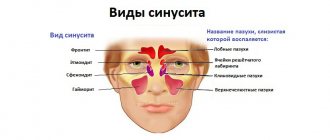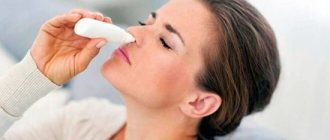What medications are used to treat sinusitis?
Recovery from sinusitis depends on choosing the right combination of medications: if the wrong medications are selected, the acute stage of the disease can become chronic and significantly worsen the quality of life of both the child and the adult. The selection of drugs for sinusitis should be trusted only to the attending physician. The course of treatment may include local or systemic antibiotics, antihistamines, pain relievers and antipyretics, as well as sea water-based remedies for sinusitis and sinusitis, which help thin mucus and flush out harmful microorganisms and allergens from the nasal cavity.
A special place in the treatment of sinusitis is occupied by the use of vasoconstrictors. This group of medications, in the form of drops or sprays, helps relieve swelling and reduce mucus formation. Vasoconstrictor medications for sinusitis and other forms of sinusitis help relieve nasal congestion, which causes significant discomfort and interferes with normal breathing. Also, as part of the comprehensive treatment of sinusitis, it is recommended to use mucous moisturizers. Moisturizing nasal sprays have a more gentle effect and have clear advantages compared to traditional vasoconstrictor medications.
Why does a child develop sinusitis?
The cause of sinusitis is most often a bacterial pathogen of streptococcal or staphylococcal nature1. In most cases, the disease occurs as a complication of ARVI, rhinitis, otitis and other problems in the nearby ENT organs.
Risk factors for developing infection in childhood:
- decreased immunity, frequent colds;
- chronic diseases that weaken the body;
- proliferation of adenoid vegetations and their inflammation;
- tendency to allergic processes in the nasopharynx;
- polyps in the nasal cavity and surrounding sinuses;
- congenital and acquired curvature of the nasal septum;
- lack of timely and correct treatment of diseases of the respiratory system, caries, infections of the ear and tonsils2.
Treatment of sinusitis should begin immediately, otherwise there is a high risk of complications.
Rinomaris® for the treatment of sinusitis
Rinomaris® is a modern vasoconstrictor drug in the form of a nasal spray that helps to quickly cope with nasal congestion.
It contains two complementary components: xylometazoline, which constricts the vessels of the nasal mucosa and eliminates its swelling, and a solution of Adriatic Sea water. Microelements of sea water help thin nasal mucus and make it easier to remove, which helps prevent mucus from stagnating in the nasal cavity and preventing the creation of favorable conditions for the proliferation of bacteria. Thus, Rinomaris® allows you to cope with nasal congestion and prevent the development of complications of the disease (sinusitis or otitis). The drug has a long-lasting effect (10–12 hours) and begins to work within a few minutes after injection. The bottle is equipped with a special 3K® dosing system, which ensures sterility and allows no preservatives to be used. Rinomaris
is an innovative remedy for relieving nasal congestion, which belongs to the so-called.
“new generation” of drugs for the common cold. To learn more
Acute sinusitis: how to prevent the disease from leading to serious complications?
09.12.2020
Today, almost every person has heard about such a disease as acute sinusitis . The most important thing to know is what sinusitis and how not to “start” the disease. So, acute sinusitis is an acute inflammation of the maxillary sinuses. The maxillary sinuses are two cavities (or scientifically “sinuses”) located in the thickness of the upper jaw, therefore there is another name for the disease: “maxillary sinusitis”.
Causes of acute sinusitis
In order to understand how acute sinusitis , you need to understand what happens in the nasal and sinus when the disease occurs. In the nasal there is a mucous membrane that extends into the sinus cavity. In turn, the sinus “opens” into the nose with the help of an opening or anastomosis. When inflammation begins in the nose , active growth of bacteria occurs, which enter the sinus through the anastomosis. And due to severe swelling of the nasal , the anastomosis closes, and bacteria that have entered the sinus begin to grow in it, causing inflammation. teeth can also be a common cause of sinusitis . The fact is that some of the teeth of the upper jaw descend with their roots into the sinus cavity. When there is an inflammatory process in a tooth, it spreads to the mucous membrane of the sinus. Much less often, sinusitis can develop due to decreased immunity , especially with long-term chronic diseases.
Thus, the causes of acute sinusitis are:
- difficulty in nasal breathing caused by acute inflammation in the nose ;
- the presence of purulent inflammation in the teeth ;
- decreased immunity .
Symptoms of acute sinusitis
- Runny nose with purulent discharge, sometimes mixed with blood nasal congestion , less often sneezing
- Headache that gets worse when bending your head forward or down
- Pain, feeling of heaviness and “bloating” in the cheek area
- Sometimes patients feel pain in the eyes and a feeling of pressure on the eyes
- Pain in the teeth of the upper jaw
- Weakness, malaise, feeling weak, body temperature (usually about 38°C), fatigue
Diagnosis of acute sinusitis
Often, there are no difficulties in diagnosing acute sinusitis . For this purpose, the patient must be examined by an otolaryngologist. The diagnosis is made on the basis of complaints and medical history, examination data, X-ray examination (lately computed tomography of the paranasal sinuses is more often used), a general blood , a smear from the nasal or sinus for microflora and sensitivity to antibiotics.
Upon examination (the method is called “anterior rhinoscopy”), reddened and swollen nasal with purulent or mucopurulent discharge is revealed. The doctor also evaluates the condition of the nasal (it happens that it is curved, which can significantly worsen the treatment process). Next, tapping (or “percussion”) of the anterior walls of the maxillary sinuses is carried out; with severe inflammation, the patient will feel pain.
An X-ray examination or computed tomography allows you to accurately establish the diagnosis and assess the condition of the sinuses, which will allow you to prescribe the correct treatment.
A blood test usually shows an increase in leukocytes, ESR, and band neutrophils.
A smear will show which microbe caused this inflammation, and determining sensitivity will help you choose the right drug.
Treatment of acute sinusitis
Acute sinusitis is treated with antibiotics. At the first visit to the doctor, a broad-spectrum antibiotic is prescribed. And when the smear result is ready, the antibiotic can be replaced, unless the microbe is already sensitive to the drug. In order to remove swelling in the nose nasal drops for a period of 5 to 7 days. Antihistamines (antiallergic) drugs are also prescribed. Herbal mucolytic preparations have a good effect; they promote liquefaction and better drainage of sinus contents.
Rinsing the nasal and sinuses with saline solutions allows you to remove contents from the nose . Washing can be carried out at home with special devices purchased at a pharmacy, or in medical institutions using an aspirator and nozzle.
The most common procedure for the treatment of sinusitis is puncture of the maxillary sinus. A puncture (or in common parlance “puncture”) allows you to quickly remove pus from the sinus and significantly speed up recovery.
a doctor on time and begins treatment, the recovery process will begin much earlier, and many complications associated with acute sinusitis .
Published in Otorhinolaryngology Premium Clinic
Naphthyzin
A fast-acting vasoconstrictor for infectious rhinitis, hay fever, and sinusitis accompanied by debt. The drops almost instantly reduce the lumen of the capillaries; after just a minute of their use, breathing becomes freer. The effect lasts up to 6–8 hours. It is necessary to use Naphthyzin only when there is severe congestion, for example, at night. The course is no more than 5 days. Long-term use can cause addiction and decrease the sensitivity of blood vessels to the active substance. Naphthyzin should be used especially carefully in children. To eliminate a runny nose, it is allowed from 1 year.
Hormonal drugs
Nasal drops containing glucocorticosteroids are prescribed for extremely severe sinusitis, which is accompanied by severe swelling of the mucous membrane, which is not eliminated with the help of vasoconstrictors.
Drugs in this group also have a local anti-inflammatory effect. They are used once a day for 5 days.
Hormonal drops are not allowed for pregnant women, during lactation and children under 5 years of age.
Avamis, nasal spray 27.5 mcg/dose, 120 doses (620 rubles)
Contains the synthetic glucocorticosteroid fluticasone furoate. The drug has a pronounced anti-inflammatory effect.
Avamis is approved for use in pediatric practice in children over 2 years of age. Also, on the recommendation of the attending physician, use by pregnant women is permissible.
Nasonex, nasal spray 50 mcg/dose, 120 doses (RUB 785)
The active ingredient is mometasone.
It is used in the treatment of allergic sinusitis, chronic runny nose, and sinusitis.
The drug is allowed to be used for the treatment of allergic rhinitis in children over 2 years of age.
X-ray characteristics of the maxillary sinuses
X-rays of the maxillary sinuses should be interpreted not by a radiologist, but by the attending otolaryngologist. Accumulations of pus in the nasal sinuses and their swelling are often equally visualized on radiographs. If you mistake the swelling for purulent accumulations, then you can make a puncture in vain, which will not give any positive results. Often, the liquid contents of the maxillary sinus with sinusitis are characterized by a clear visual level, which allows us to talk about its purulent nature.
With normal darkening of the sinuses, the results of radiography must be supported by other types of diagnosis . It is unacceptable to practice when a diagnostic puncture is performed for the sole purpose of determining the presence of pus in the sinus. An MRI or CT scan often allows one to clarify the results of an x-ray examination and differentiate between normal swelling and the presence of pus. The same applies to ultrasound scanning of the sinuses.
3.Rinse the nose using the Proetz method
The essence of this technique is to rinse the nasal sinuses through catheters, through one of which the solution is supplied, and through the other it is pumped out using a vacuum pump. This is a painless procedure that only requires control of the patient’s condition and breathing. In order to prevent the rinsing solution from entering the respiratory tract, the patient must make certain movements with the throat, similar to pronouncing the sounds “ku-ku”. For this reason, the popular name for such washing is “cuckoo”. Removing pus from the nasal sinuses according to Proetz provides relief after the first session, but for recovery the course should include 5-7 rinses. Typically, the washing procedure is carried out with the help of a health care worker, and the patient lies on his back.
Special devices have been developed for home rinsing of the nose for sinusitis, such as, for example, “Dolphin”
. It is recommended to wash with Dolphin using a mineral-plant solution. This is a convenient way to alleviate your condition and speed up recovery without resorting to outside help.
How to distinguish sinusitis from a runny nose
Unlike a common runny nose, sinusitis is often accompanied by a temperature (sometimes quite high), in addition, the patient suffers from aching headaches and facial pain in the sinuses, and a feeling of heaviness appears in the area of the bridge of the nose and the teeth of the upper jaw.
Question and Answer
Is it true that improper nose blowing can lead to sinusitis? Usually all these troubles are accompanied by difficulty breathing and mucus from the nose. But if with a normal runny nose the discharge is usually clear, watery and odorless, then with sinusitis the mucus becomes thick, acquires a yellow-green tint and a specific smell. This is already purulent discharge, which indicates the addition of a bacterial infection and the development of sinusitis.










